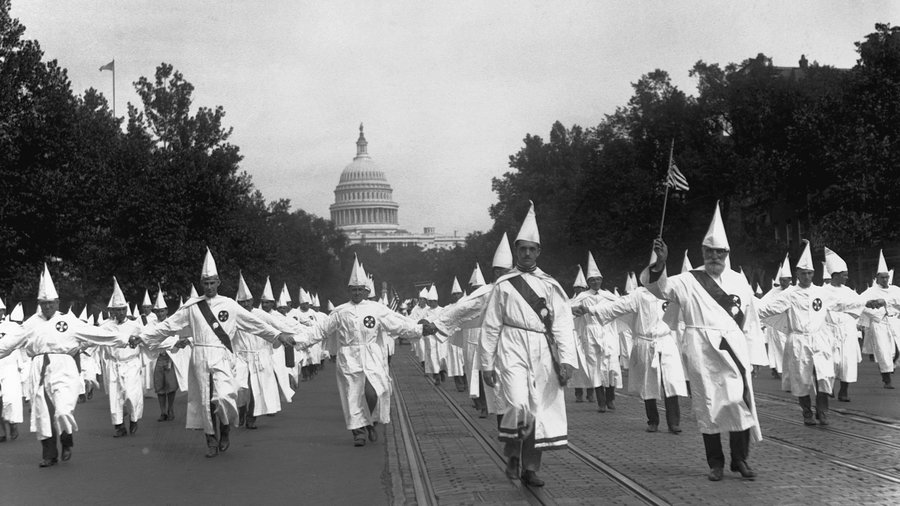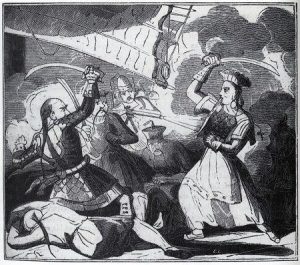Since its origins, the infamous Ku Klux Klan has influenced the attitudes and views of many Americans. The KKK will forever be recognized as the largest political hate group in United States history. Despite the rise and fall of the Klan, it wasn’t until the 1920s that it rose to its highest peak in prominence. During this time period, there was exponential growth in both membership in and support for this notorious cult. The KKK was a growing cult in the 1920s because it instilled religious beliefs, terror, and a skewed view of a better America into the minds of its members through its propaganda of racial superiority.
The original KKK arose during the Reconstruction era of the 1860s and 1870s, and was primarily aimed at restoring the antebellum racial hierarchy to the South. However, it declined in the 1870s due to the passing of legislation aimed at stopping Klansmen’s voter intimidation activities and associated hate crimes. With the end of Reconstruction in 1877, and the passage of Jim Crow laws throughout the South, Klan activity and Klan membership declined. But the cult began a strong resurgence in 1915, with membership skyrocketing to nearly four million by the year 1920.1 This time, the focus of their efforts was aimed at “Americanizing” people by promoting the Constitution, the flag, and the Bible.2 This white supremacist organization lashed out at any group whose ideals conflicted with their own, especially that of African Americans, Catholics, and Jews.

The revival of the Klan was led by its notorious second Grand Wizard (the KKK’s primary leader), William J. Simmons, who was a preacher, a veteran, and an extreme white supremacist.3 He was inspired to reorganize the Klan after watching the silent movie Birth of a Nation, which depicted the Klan as a saving grace, defending the birthright of white southerners and greatly enhancing the public opinion of the cult.4 The religious implications of the KKK stemmed from the teachings of Simmons. Not only were his sermons effective at grasping the hateful minds of Klan members, but he truly convinced them that they were doing the work of God; his credibility led him to a position of power. In fact, one could not join the Klan unless one practiced “militant Christianity,” living in such a way as to be an example to others by following laws, abstaining from drinking, gambling, infidelity, and by not neglecting one’s family. Members were to attend church services regularly, always adhering to the foundations of the Christian faith.5 In addition to this, the KKK burned crosses, often arguing that it was to symbolize the spread of Jesus’ light; it was a symbol aimed to “drive away darkness and gloom.”6 The heavily emphasized morals and negative attitudes toward others are what drove the cult’s frame of thought. Often interpreted in a hateful manner, the religious implications instilled by the KKK’s leaders too often brewed inaccurate thoughts in the minds of its followers; thus, many assumed that the answer to their problem was to commit radical acts of terror.

In addition to their cloaking themselves in the trappings of Christianity, the Klan also used terror tactics to instill fear into both its own members and to those it targeted. The members saw themselves as vigilantes in the restoration of justice—using intimidation, violence, and terror to prevent people of color from attaining any sort of social status or political power. They burned crosses, led beatings, committed assassinations, lynchings, and much more.7 While the symbol of the KKK, the burning cross, held religious connotations for its own members, it was also used as a form of intimidation. They used this symbol of a burning cross to terrorize African Americans.8 In addition to intimidating African Americans, the Klan also targeted Catholics, and had a particularly strong concern with this group due to the fact that they practiced a “different religion” from their own. The motivation for this anti-Catholicism is deeply rooted in American history, going all the way back to colonial times. And with the dramatic increase of Catholics immigrating from Ireland, Italy, and Germany in the nineteenth century, anti-Catholicism was a mainstay throughout American life in the early decades of the twentieth century.9 With the ethnic, social, and racial diversity of American life, tensions continued to heighten among the opposing whites who sought to rid America of these many “outsiders” — a long-held notion in American society. In using both verbal and physical threats, the terror inflicted by the cult caused people to fear the power of the invisible empire that was the KKK.
The idea of creating a better America was yet another reason for the Klan’s rise to prominence in the 1920s. The KKK fought for stricter enforcement of prohibition laws, sought to eliminate political corruption, and wanted to eradicate any form of immigration. Any seemingly “foreign-born” citizen that crossed the path of a klansman was deemed un-American. The Klan assumed they were doing the nation its due diligence in suppressing these “outsiders.” At its peak, the Klan even managed to get political leaders to seek their support and endorsement, since many Americans at this time sympathized with the Klan and its mission.10 And as membership grew, so did their influence. Their opposition to non-whites and to immigration helped to secure the passage of strict quotas on those seeking to come to America.11 The KKK was influential in more ways than one — their power reigning heavily on American society. Even today, white supremacists seek to have their voices heard and their views seen as legitimate. The fight for racial toleration is certainly far from over.

On the other hand, some say that the resurgence of the KKK in the 1920s was due primarily to the effects of industrialization, urbanization, and immigration on society. White Americans became uneasy about immigration and “outsiders” taking American jobs. Many could not stand the idea of “those people” diluting the “racial purity” of American society. But the idea of racial purity is a myth–yet a strong one that many white racists wish to be true. The original soil of America was populated by immigrants and natives alike; whites simply claimed it as their own, as they were to be the guardians of a “city on a hill” and as part of their “manifest destiny” to be the bearers of a supreme culture and society.12 Those that looked to this cult to justify their own beliefs do not parallel with what it means to be an independent individual in American society. The people they were trying to drive out had just as much freedom to be in the United States as they did. Others in support of the Klan also claimed that Simmons was, in fact, preaching for the betterment of society, and that he never resorted to violence to solve problems; though this may seem true, Simmons was actually insinuating his own, twisted version of the word of God, often emphasizing ideas of white supremacy and racial segregation as if that was God’s will. In a pamphlet he wrote in the early nineteenth century, he even states that the primary goal of the organization is to preserve ideals of pure Anglo-Saxon civilization, and many claimed he preached themes of being a pro-American leader by hinting in his sermons that any person in opposition to traditional thought of Anglo supremacy was unwelcome, and simply un-American.13 He silently, yet deviously, instilled discrimination into the Klan’s members. It was even noted that Catholic priests, Protestant ministers, and Jewish rabbis came forward to condemn the organization and its false teachings.14 It seems that the religious implications, terroristic acts, and the skewed ideals used in order to insinuate the making of a better America are contradictory to both the Klan’s mission and the symbols they claimed to uphold.
With a religious basis, the Klan movement emphasized legal and political approaches to solving the “moral crisis” in 1920s America.15 The cult rose to prominence in the 1920s because of their religious, terroristic, and “ideal American” implications; however, their resurgence only served as a detriment. The second coming of the Klan was significant in that it rose to its highest peak in prominence. The KKK’s second coming only continued to fuel the long-held idea of hatred and discrimination that still lingers in the minds of many today.
- Khan Academy, 2016, s.v. “The Reemergence of the KKK,” by Dr. Michelle Getchell. ↵
- David A. Horowitz, Inside the Klavern: The Secret History of a Ku Klux Klan of the 1920s (Carbondale: Southern Illinois University Press, 1999), 10. ↵
- David A. Horowitz, Inside the Klavern: The Secret History of a Ku Klux Klan of the 1920s (Carbondale: Southern Illinois University Press, 1999), 11. ↵
- Roland G. Fryer, “Hatred and Profits: Under the Hood of the Ku Klux Klan,” Quarterly Journal of Economics 127, no. 4 (November 2012): 12. ↵
- Holley Donald, “A Look Behind the Masks: The 1920s Ku Klux Klan in Monticello, Arkansas,” The Arkansas Historical Quarterly no. 2 (2001): 19. ↵
- David Cunningham, “Top 5 Questions About the KKK,” PBS, 2013. Accessed March 12, 2018. http://www.pbs.org/wgbh/americanexperience/features/klansville-faq/. ↵
- Khan Academy, 2016, s.v. “The Reemergence of the KKK,” by Dr. Michelle Getchell. ↵
- PBS, 2013, s.v. “Top 5 Questions About the KKK,” by David Cunningham. ↵
- Mark Paul Richard, Not a Catholic Nation: The Ku Klux Klan Confronts New England in the 1920s (Amherst: University of Massachusetts Press, 2015), 11. ↵
- American Decades, 2001, s.v. “After the Great War: Nativism and the Ku Klux Klan,” by Judith S. Baughman, et.al. ↵
- Gale Encyclopedia of American Law, 2011, s.v. “Ku Klux Klan,” by Donna Batten. ↵
- Khan Academy, 2016, s.v. “The Reemergence of the KKK,” by Dr. Michelle Getchell. ↵
- William J. Simmons, “Pamphlet for the Ku Klux Klan Written by Colonel William Joseph Simmons,” Smithsonian, 2017. Accessed April 6, 2018. https://nmaahc.si.edu/object/nmaahc_2011.155.15. ↵
- Khan Academy, 2016, s.v. “The Reemergence of the KKK,” by Dr. Michelle Getchell. ↵
- Holley Donald, “A Look Behind the Masks: The 1920s Ku Klux Klan in Monticello, Arkansas,” The Arkansas Historical Quarterly no. 2 (2001): 14-15. ↵




122 comments
Carlos Robles
The Klu Klux Klan used to scare me a lot as a child. I heard a lot of horrific things about them as a child. The burning of the crosses is a horrible thing to do. I just found out due to this article that it means to “drive away darkness and gloom.” A quote from this article that really stood out to me was “The idea of creating a better America was yet another reason for the Klan’s rise to prominence in the 1920s.” The phrase “creating a better America” sounds very familiar to me.
Enrique Segovia
I feel that I really learned something new with this article. First of all, I was not cognizant that the Ku Klux Klan had branches of belief, nor did I know of their most recognized leader, William J. Simmons (the KKK’s Second Grand Wizard). I was familiar with what the KKK pursued as their goal, and after reading this article, I feel even more perplexed and vexed by their supremacist ideas. In more detail, what annoyed me the most, is that the KKK tries to tie their concepts and values to religion; they marry the belief of intolerance towards other religions, being racist, and trying to universalize or “Americanize” the rest of the Southern United States, which is just proof of their evil intentions as white supremacists.
Erin Vento
This was a really enlightening article about the biggest hate group American has/had. I always knew that KKK members were evil and racist, but I had never really thought about why they thought that way (and the obvious flaws in those ideas). I like also like that you connected it to things and ideas that are going on currently.
Luis Morales
This article was very well written, and very informative. I did not know that there were two versions of the Ku Klux Klan, or that they had different values. Although the reemerged clan used religion as the basis for their beliefs, hatred is still what kept them in power. It is disgusting that people have this type of mentality. It is even more disgusting that it is still partly evident today with our country divided by racial controversies. Excellent job!
Cristina Cabello
You did really well on this topic. I always found it interesting to read about the K Klux Klan. But this is truly is a shameful group. It is really heartbreaking to find out that their founder was a Christian priest. Having a “religious man” engage in even more terror is frightening. It just proves that you really don’t know who people are. Overall this was a well developed story.
Hannah Wilson
This article was very well-written and offered a lot of information for the reader. I did not know that there were two prominent periods of the Ku Klux Klan’s reign of terror and influence. It is disturbing that the leader in the 1920’s was a priest because it is the opposite of the way a Christian should think and act. It is even more disturbing to me that the amount of Americans that would join a hate cult was up to the millions.
Iris Henderson
This was an excellent and informative article to read. While I feel that I have learned a lot about the history of the Ku Klux Klan, this article provided many pieces of new information. One these facts being, the KKK also targeted other white people of different faiths. It was also interesting to learn how Simmons relied on his version of the word of God to instill his own values onto these morally weak individuals. Overall, this article flowed really well and the story was captivating.
Hanadi Sonouper
This was a well told expressed article about the KKK, I had known the basics about their history and racial discrimination against others, but this article gave lots of insight as to how it all began. It is despicable that our nation was once a boiling point of such cruel judgement, what I did not know, what that the KKK’s power really grew during the 1920’s. It is disgusting that a people have this type of mentality, and although it has been taken down drastically, it is still partly evident today with our country divided by racial controversies. Overall it was a great article, excellent job!
Belia Camarena
This article was very well written, and very informative. I was not aware that there is two variations of the Ku Klux Klan, or that they kind of had different values. Although the reemerged clan used religion as the basis for their beliefs, hatred is still what kept them in power, and it is sad to think of the crimes they committed “in the name of God”.
Robert Flores
I can see now why the leader of the ku klux klan today like the president they both are in support of the same thing. like getting rid of the corruption in the government and preventing foreigners from entering the country. It is really sad to hear that the grand wizard was a priest when christianity is supposed to be against hate.